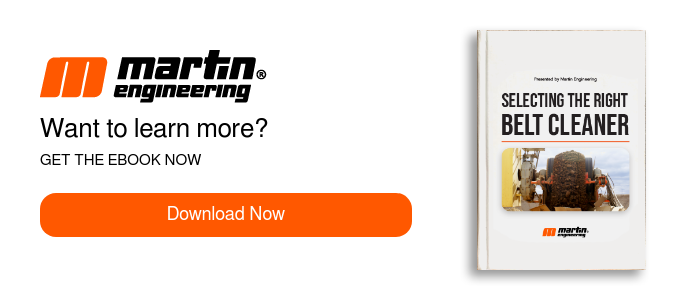Where To Position Primary Conveyor Belt Cleaners
Effective Primary Cleaner Installation
The primary cleaner, also known as the pre-cleaner or doctor blade, is positioned on the face of the head pulley just below where material discharges from the belt trajectory. This placement allows removed material to fall in line with the main cargo as it exits the belt, minimizing overload in the dribble chute or other reclamation systems.
Pre-cleaners are designed with low blade pressure but an aggressive angle of attack to shear coarse grit from the carryback layer. This effectively clears most of the carryback, allowing the secondary cleaner to address any remaining material underneath. The primary-cleaner blade should be installed in a positive-rake position, angled against the belt and pulley movement at approximately 30 to 45 degrees relative to a tangent line on the belt's surface where it contacts the blade. Instead of obstructing material flow, the pre-cleaner redirects material away from the belt, ensuring it returns to the main material flow or moves down the back of the cleaner into the discharge. This low angle of attack, coupled with elastomer pre-cleaner blades applied lightly against the belt, minimizes wear on both the blade and belt surface.
A greater angle of attack, such as a zone-rake or negative rake position, would necessitate higher blade pressure to counter the material's impact, increasing the risk of belt damage. To mitigate this risk to the belt, splice, and cleaner, pre-cleaners typically use resilient elastomer blades, like urethane or rubber, rather than metal. Maintaining a blade-to-belt pressure around 14 kilopascals (2 lbf/in.²) balances effective cleaning with belt safety. This low pressure allows the system to release or bounce the blade away from the belt when encountering obstructions like mechanical splices, reducing potential damage.
Applying proper cleaning pressure extends blade life and reduces belt wear. Insufficient pressure can allow material to wedge between the blade and belt, causing wear. Excessive pressure accelerates wear and increases the energy required to move the belt. Using a single pre-cleaner without additional cleaners typically requires higher blade-to-belt pressure than recommended for optimal belt longevity.
